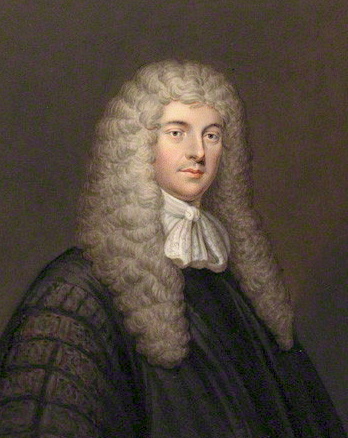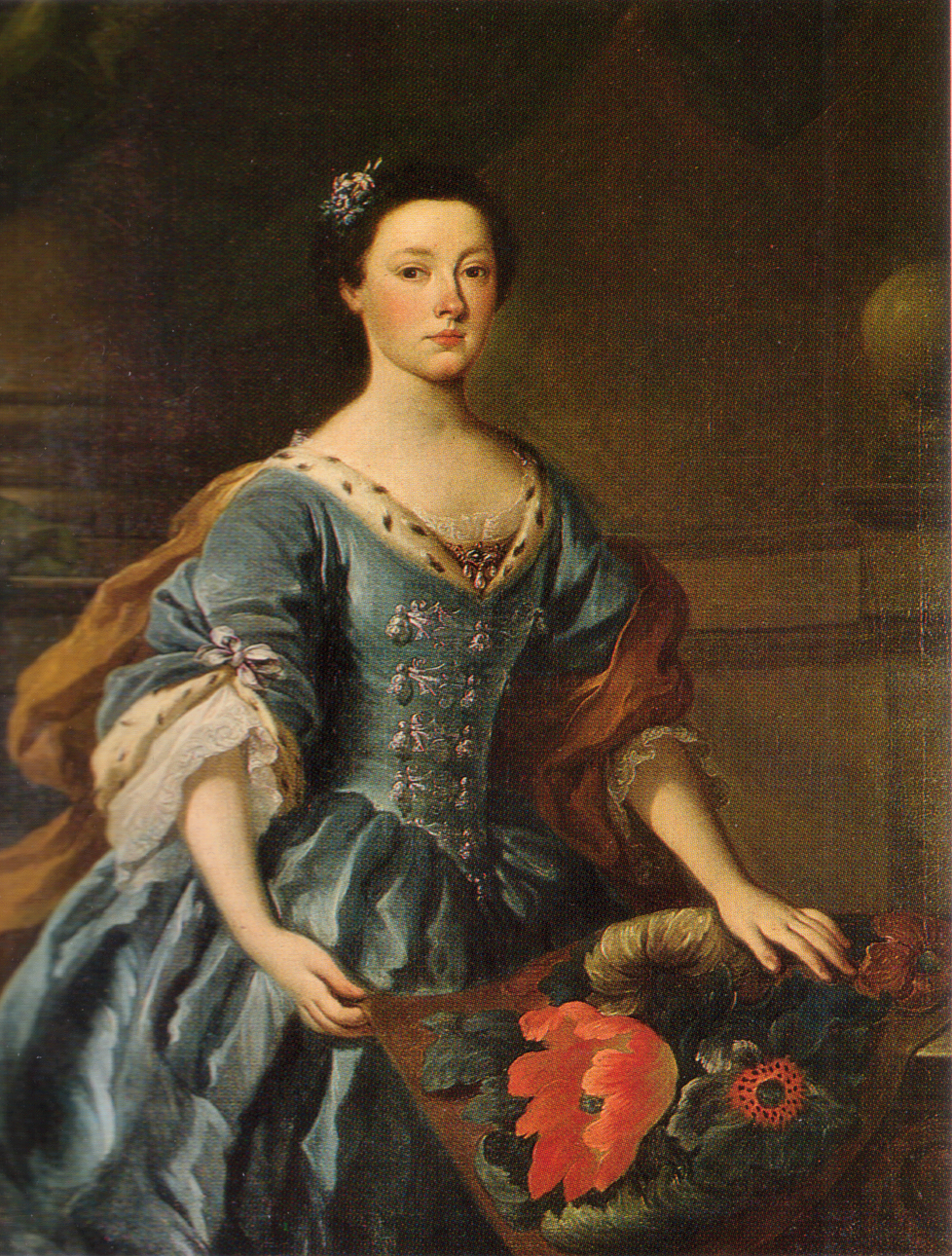|
Stoke Edith Wall Hanging
The Stoke Edith Wall Hanging is an embroidered wall hanging made in 1710–20, depicting elegant people walking in an early 18th-century garden. This is the larger of two such works which originally hung in Stoke Edith in Herefordshire. The Stoke Edith House was built in 1697 for Paul Foley, Speaker of the House of Commons, and finished by his son Thomas, an MP and wealthy landowner. After a visit by the leading garden designer George London in 1692 the park and gardens were remodelled to his suggestion, and it is likely that pleasure grounds would have been laid out around the house in a series of formal compartments with geometric walks, flower-beds and fountains. The house was destroyed by fire in 1927. Prior to this the hangings hung in the green velvet bedroom, between the dado and the ceiling. After the fire they were kept by the Foley family in London. The hanging shows couples strolling, the long shadows suggesting a late afternoon in summer. A gentleman doffs his hat w ... [...More Info...] [...Related Items...] OR: [Wikipedia] [Google] [Baidu] |
Stoke Edith
Stoke Edith is a village in the English county of Herefordshire, situated on the A438 road between Hereford and Ledbury. The population in 1801 of Stoke Edith parish was 332. The 14th-century church of St Mary is a grade I listed building. It has an immaculate needle spire set behind a parapet recess. The Foleys rebuilt the stone church completely in 1740. It has five bay arcades in the nave ended by large Tuscan columns. The church has a communion rail, pews and font in the same period with an impressive wooden pulpit in three decks. There remains an alabaster image of a 15th-century noblewoman with a distinctive headdress. The monument dated 1699 is to Paul Foley, the first to move from Great Witley, co-leader of the Tory Party and Country Whigs. There are tablets to a Henry Wolstenholme and his wife. The church is currently being transferred to a private trust, but is temporarily closed over safety concerns. Stoke Edith House The estate and the manor house known as Sto ... [...More Info...] [...Related Items...] OR: [Wikipedia] [Google] [Baidu] |
Stoke Edith House
Stoke Edith House is a derelict country house with surrounding park in Stoke Edith, Herefordshire, England. The present 17th century quadrangular mansion was preceded by a multi-gabled, Elizabethan home. Set within gardens, it was destroyed by fire in 1927. History Stoke Edith was the principal manor of Sir Henry Lingen (1612 – 1662), Royalist cavalier. He and the resident rector, Henry Rogers, denounced for their political leanings, knew the property could be victimized at any time. Lingen's widow, Alice Pye of the Mynnd, sold the manor in the 1670s to the ironmaster Thomas Foley, who settled it on his second son Paul. Paul obtained licence from James II to empark up to 500 acres at Stoke Edith. After a visit by the leading garden designer, George London, in 1692, the park and gardens were remodelled to his suggestion, and it is likely that pleasure grounds would have been laid out around the house in a series of formal compartments with geometric walks, flower-beds and fou ... [...More Info...] [...Related Items...] OR: [Wikipedia] [Google] [Baidu] |
Paul Foley (ironmaster)
Paul Foley (1644/5 – 13 November 1699), also known as Speaker Foley, was the second son of Thomas Foley of Witley Court,''Burke's Peerage'' the prominent Midlands ironmaster. Ironmaster He took over his father's ironworks in and around the Forest of Dean in the early 1670s and continued them until 1685 when he let them to John Wheeler and Richard Avenant, who had managed ironworks for his brother Philip Foley. In 1692, the two brothers entered into a partnership with these managers and John Wheeler's brother, Richard. This lasted until after Paul's death. Gentleman Paul Foley had the resources from his father and the profits of his ironworks to buy himself a substantial estate around Stoke Edith in Herefordshire, part of which still belongs to a descendant. Important purchases included Stoke Edith from the trustees of Sir Henry Lingen in 1670 (made by his father), [...More Info...] [...Related Items...] OR: [Wikipedia] [Google] [Baidu] |
George London (landscape Architect)
George London (c. 1640–1714) was an English nurseryman and garden designer. He aspired to the baroque style and was a founding partner in the Brompton Park Nursery in 1681. Henry Wise (1653–1738) was his apprentice, and the two later worked as partners on parterre gardens at Hampton Court (where they designed Hampton Court Maze), Chelsea Hospital, Longleat, Chatsworth, Melbourne Hall, Wimpole Hall and Castle Howard. His garden designs at Hanbury Hall near Bromsgrove have been re-instated using plans, contemporary surveys and archaeological evidence. George London's birth date is not certain but it was probably about 1640. His black grave slab is inside All Saints Church, Fulham, where he is buried with his wife Elizabeth. George was gardener to Henry Compton at Fulham Palace, Fulham Fulham () is an area of the London Borough of Hammersmith & Fulham in West London, England, southwest of Charing Cross. It lies on the north bank of the River Thames, bordering Hammer ... [...More Info...] [...Related Items...] OR: [Wikipedia] [Google] [Baidu] |
Tent Stitch
Tent stitch is a small, diagonal needlepoint stitch that crosses over the intersection of one horizontal (weft) and one vertical (warp) thread of needlepoint canvas forming a slanted stitch at a 45-degree angle. It is also known as needlepoint stitch and is one of the most basic and versatile stitches used in needlepoint and other canvas work embroidery. When worked on fine weave canvas over a single warp and weft thread it is known as petit point in contrast to stitches, such as Gobelin, worked over multiple warp and/or weft threads. "Petit point" comes from the French language French ( or ) is a Romance language of the Indo-European family. It descended from the Vulgar Latin of the Roman Empire, as did all Romance languages. French evolved from Gallo-Romance, the Latin spoken in Gaul, and more specifically in Nor ..., meaning "small point" or "dot". Tent stitch variants There are three types of tent stitch, all producing the same appearance on the front of the can ... [...More Info...] [...Related Items...] OR: [Wikipedia] [Google] [Baidu] |
Victoria And Albert Museum
The Victoria and Albert Museum (often abbreviated as the V&A) in London is the world's largest museum of applied arts, decorative arts and design, housing a permanent collection of over 2.27 million objects. It was founded in 1852 and named after Queen Victoria and Prince Albert. The V&A is located in the Royal Borough of Kensington and Chelsea, in an area known as "Albertopolis" because of its association with Prince Albert, the Albert Memorial and the major cultural institutions with which he was associated. These include the Natural History Museum, the Science Museum, the Royal Albert Hall and Imperial College London. The museum is a non-departmental public body sponsored by the Department for Digital, Culture, Media and Sport. As with other national British museums, entrance is free. The V&A covers and 145 galleries. Its collection spans 5,000 years of art, from ancient times to the present day, from the cultures of Europe, North America, Asia and North Africa. Ho ... [...More Info...] [...Related Items...] OR: [Wikipedia] [Google] [Baidu] |
Collections Of The Victoria And Albert Museum
Collection or Collections may refer to: * Cash collection, the function of an accounts receivable department * Collection (church), money donated by the congregation during a church service * Collection agency, agency to collect cash * Collections management (museum) ** Collection (museum), objects in a particular field forms the core basis for the museum ** Fonds in archives ** Private collection, sometimes just called "collection" * Collection (Oxford colleges), a beginning-of-term exam or Principal's Collections * Collection (horse), a horse carrying more weight on his hindquarters than his forehand * Collection (racehorse), an Irish-bred, Hong Kong based Thoroughbred racehorse * Collection (publishing), a gathering of books under the same title at the same publisher * Scientific collection, any systematic collection of objects for scientific study Collection may also refer to: Computing * Collection (abstract data type), the abstract concept of collections in computer science ... [...More Info...] [...Related Items...] OR: [Wikipedia] [Google] [Baidu] |
English Embroidery
English embroidery includes embroidery worked in England or by English people abroad from Anglo-Saxon times to the present day. The oldest surviving English embroideries include items from the early 10th century preserved in Durham Cathedral and the 11th century Bayeux Tapestry, if it was worked in England. The professional workshops of Medieval England created rich embroidery in metal thread and silk for ecclesiastical and secular uses. This style was called ''Opus Anglicanum'' or "English work", and was famous throughout Europe.Levey and King 1993, p. 12 With the Protestant Reformation of the 16th century, the focus of English embroidery increasingly turned to clothing and household furnishings, leading to another great flowering of English domestic embroidery in the Elizabethan and Jacobean eras. The end of this period saw the rise of the formal sampler as a record of the amateur stitcher's skills. Curious fashions of the mid-17th century were raised work or stumpwork, a ... [...More Info...] [...Related Items...] OR: [Wikipedia] [Google] [Baidu] |




